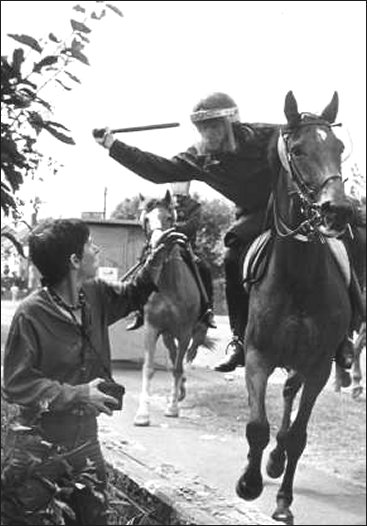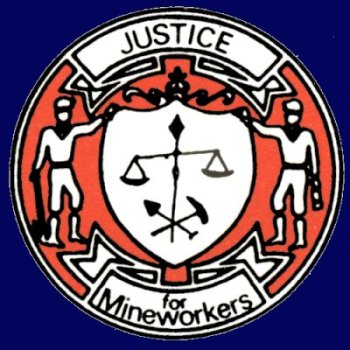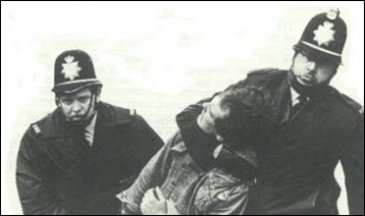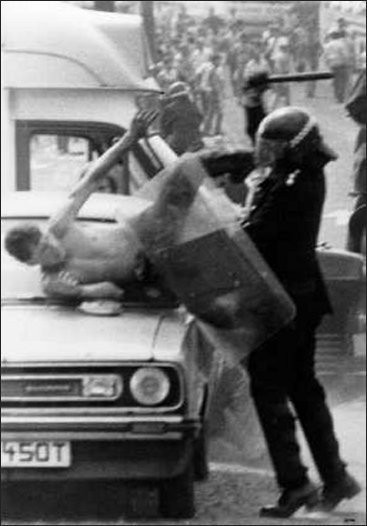| Civil
Liberties IN
THEIR frenzy to smash the miners' strike the government judiciary and the police
took gigantic steps to reduce the civil liberties of the striking miners and their
supporters. Perhaps
the first outrage was the public declaration of the Attorney General Sir Michael
Havers on a radio programme that the police had sufficient power to stop pickets
travelling to pits if they took the view that a breach of the peace might take
place. Within hours of this declaration the Kent police put a road block across
the Dartford Tunnel some one hundred miles away from the closest Midlands pits
and stopped any car that looked as if it might be carrying Kent miners, and threatening
the men with arrest if they went through the tunnel. After injunction proceedings
brought by the Kent NUM, and a considerable protest by the public, the Attorney
General remained silent, but the pattern had been set.
From then on massive
forces of police blocked various routes from the M1 leading to the Midlands pits
and prevented the miners and their supporters from getting anywhere near the pits
they wished to picket peacefully. Any foreign visitor driving along the Ml could
have been forgiven for thinking that they were entering a high security war zone
judging by the enormous numbers of police and police vehicles which either blocked
the roads, stood parked along the verges or travelled systematically in long convoys
from one area to another. No
longer could a miner exercise his lawful right to travel peacefully to any other
part of the country without being stopped. No longer could any other man or group
of men who looked like miners travel peacefully through the Midlands without being
stopped by the police. The
government openly exhorted the police to take whatever steps the police thought
necessary to stop picketing and enable the few pits that were still producing
coal to continue working. They lavished money on the police despite generally
denying there was no money for public expenditure in even the most needy areas
of the deprived inner cities. Was there an outcry from the government when one
southern constabulary chartered a jet to carry the police from the southern counties
to the Midlands for picket duties? The
government carried out an active campaign throughout the media wholly blaming
the striking miners for violence on the picket line, as well as totally ignoring
the escalating violence in the police and the continuing erosion of the public's
rights. Police were encouraged and allowed to use pre-emptive charges by batten
swinging police horsemen. They were allowed and encouraged to use snatch squads
often of heavily armoured policemen who would force their way into a line of pickets
to break up the line and give other constables opportunities to arrest pickets
without reason. Evidence at the Orgreave trial revealed internal police directions
which actively encouraged the police officers to use violence when dealing with
picketing. The
government assisted in the organisation and paid for the National Reporting Centre,
the first attempt in Britain to organise policing on a national strategic level
without taking into account any of the needs or views of local inhabitants. The
police for their part generally pursued a vigorous aggressive campaign against
striking miners. The policemen on picket duties in many areas were encouraged
to view striking miners as the enemy. The frequently used excessive violence on
even elderly miners who were arrested for trivial offences and despite the fact
that no resistance was offered by the men. The miners were abused and openly insulted
by the police who faced them on the picket lines. There was no prosecution of
police officers who were seen to assault pickets, even when clear evidence of
the attacks were shown on the television. The
police openly refused to allow pickets to speak peacefully to miners who were
going to work. The pickets who managed to get through the road blocks were kept
even a half a mile or more away from the pit gate. Gone completely are the days
when it was accepted law that a number of pickets could stand across the workplace
gate and speak to their fellow workers going into work so as to try to put the
striker's point of view. The police developed the tactic of making mass arrests
in order to completely remove pickets from the picket line, knowing that the magistrates
would impose bail conditions that were so oppressive that the result would be
that the men could no longer take part in the strike. In
Colchester the police went even further and arrested pickets who were behaving
quite peacefully so as to reduce the number of potential pickets in one area to
prevent the possibility of a breach of the peace. The Colchester police had no
intention of charging any of these men, and indeed there was no suggestion that
any crime had been committed. Nevertheless, the dozen pickets found they were
unlawfully imprisoned in a Colchester police garage for a day. Not
satisfied with the Public Order Act offences the police resorted to the ancient
crime of watching and besetting under the Conspiracy and Protection of Property
Act 1875. Several men, including a passing farmer, were arrested in their pit
village in Kent for standing on a street corner talking. All the men were found
not guilty by the magistrates, there being no evidence against the defendants.
The police rapidly dropped the case against the farmer when they realised their
blunder. The Act
was also used against 21 kent miners who were following in their motor cars behind
a convoy of four police cars, and an NCB bus. The police alleged that the occupants
of the bus were intimidated by the men in the vehicles up to half a mile behind,
and out of vision. A novel if not vicious approach by the police. All the men
were acquitted. Perhaps
the most serious prosecutions, however, were those in the Midlands and Yorkshire
where dozens of miners are accused of unlawful assembly and riot. The evidence
when presented by the prosecution was non-existent and exposed an overwhelming
prejudice of senior policemen towards the miners on strike. The country now knows
from the details of the remaining cases which were dropped by the prosecution
that there was no substance in the charges brought against the men who were doing
no more than standing up for the jobs of themselves, their workmates and their
children. It has
always been a working rule that prosecutions should not be brought unless there
is a reasonable prospect of the offence being proved. Indeed the DPP will not
prosecute a policeman accused of a crime unless there is more than a 51% chance
of the prosecution succeeding. The police during the strike, particularly in relation
to the most serious charges, worked on the basis that they should charge the miners
on the basis of prejudice, assertions made by Ministers of the government, and
senior employees of the NCB and allegations carried by the media. Pickets
have been brought before the magistrates on and off over the years, but the dispute
soon saw magistrates setting bail conditions in respect of largely trivial crimes
which were so oppressive that even the most conservative of lawyers found them
unjustifiable. Indeed, in the early days of the strike the Essex magistrates ordered
bail restrictions that prevented Kent miners from picketing at any of the three
ports in Essex where coal was being imported, even though the alleged offence
occurred at only one of the ports. This was despite the fact that some of the
alleged offences were no more than sitting down in the road. The magistrates'
aim was clearly to drive the miners out of Essex. The
magistrates in Ramsgate who first of all restricted Kent miners from picketing
anywhere in Kent, including their own pits went even further in other cases by
restricting the men from picketing anywhere at all. These magistrates took it
upon themselves to prevent the men from fighting for their jobs. The conditions
were so hastily imposed that men found that they were in breach of the conditions
by going to the local Tesco's to shop, to their doctors or the hospital and in
some instances even to their own homes. One London magistrate upon hearing that
the accused miner was not a resident in London imposed a condition of bail that
he should not come to London for any reason whatsoever. No
matter what arguments were put up by lawyers representing the miners they were
not listened to because the magistrates were showing their class colours. In Mansfield
the magistrates even had bail notices with bail restrictions pre-printed ready
to hand out to the accused miners even before their names were read out in court. What
did the High Court Judges do to prevent this appalling erosion of civil liberties?
They stood by and either condoned the erosion without any care whatsoever or formally
supported the erosion of liberties in order to suppress the miners' strike. An
application for an injunction against the Kent police for blocking the Dartford
Tunnel failed. The judge was not sufficiently interested to safeguard the individual's
rights to travel peacefully across the country. The applications to the Divisional
Court for an order preventing the police road blocks in the Midlands failed, the
court endorsing the police action. The
application to the High Court to quash Mansfield's preprinted bail notices was
lost, the judges endorsing the magistrates' actions. Already
the general erosion of civil liberties which occurred during the miners' strike
is being felt by the public. There are calls for longer prison sentences by those
in power. Magistrates now feel much more ready to impose stringent bail conditions.
The police have developed an aggressive mode of dealing with other strikers and
dissenters. The Police and Criminal Evidence Act was passed by Parliament giving
the police much wider powers to deal with the public. Plastic bullets and tear
gas will be used in inner city disturbances and it will not be long before a coach
load of CND supporters are prevented from travelling to a demonstration. Those
who have fought for civil liberties over the past fifty years are aware of the
adage – "give the police an inch and they will take a mile". Date
this page updated: September 29, 2006
| 



